15 Small Living Room Layout Ideas That Maximize Space
Small Living Room Layout Ideas can be charming, but they become tricky when furniture blocks doors, cables snake everywhere, and the TV is too close for comfort. The good news? You don’t need more square meters—you need smarter moves. Start with a tape measure, choose one clear focal point, and use furniture that looks light on its feet. Add a right-sized rug to stitch everything together, keep storage vertical, and let mirrors bounce light around. Most of all, stay flexible. A couple of nesting tables, a storage ottoman, and two small stools can shape-shift for guests, movie nights, or working from home.
1) Measure First, Then Plan the Flow
Small Living Room Layout Ideas Grab a tape measure and note the room’s length, width, and the swing of any doors. Measure windows, radiators, and the depth of skirting so furniture won’t clash. Sketch a simple floor plan or use a free app to drag in sofa, chair, rug, and TV shapes at the right sizes. Now draw your daily routes: entry to sofa, sofa to window, sofa to kitchen. Those are your “traffic lanes.” Protect them. It also gives you courage to try smarter layouts—like floating the sofa or choosing an L-shape—because you can “see” the room working before you move anything.
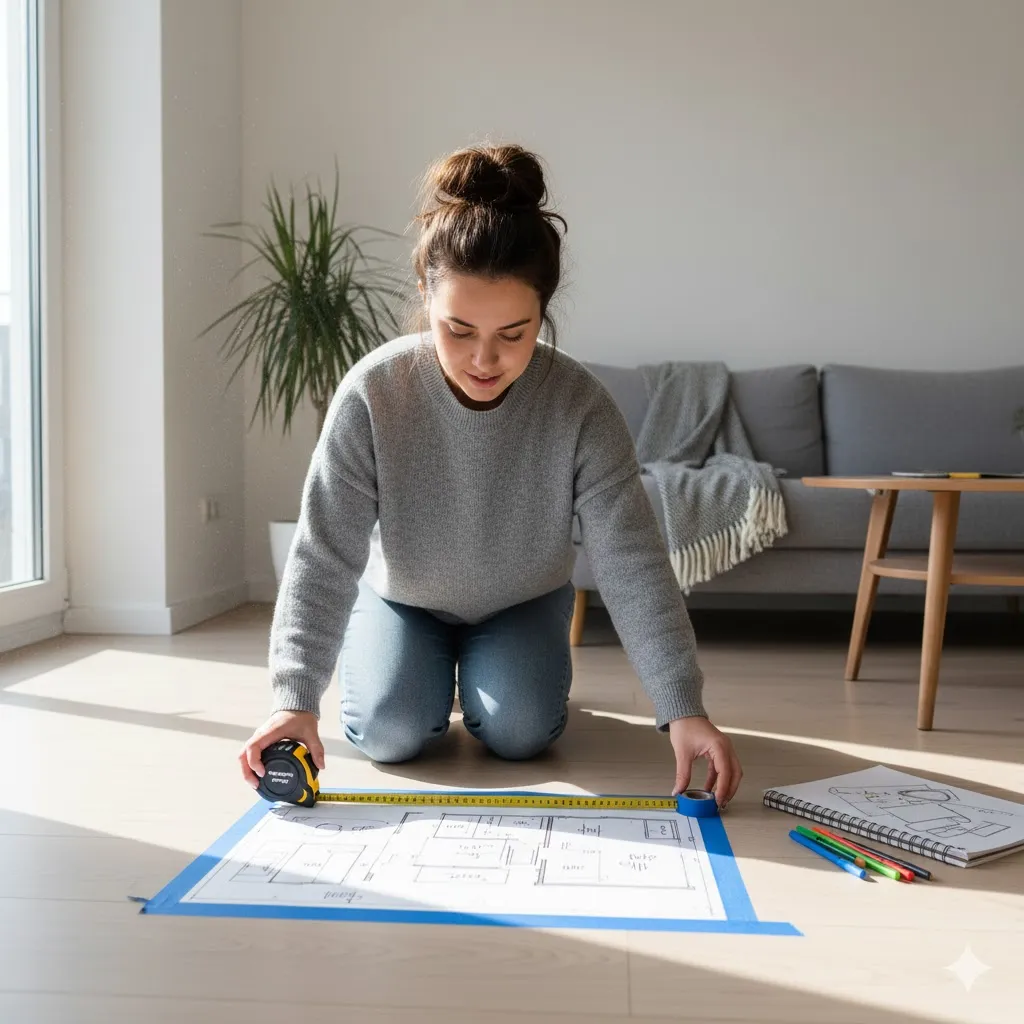
List Your Must-Haves and Nice-to-Haves
Write two short lists. Must-haves might be seating for three, a TV spot, a reading lamp, and a surface for drinks. Nice-to-haves could be a display shelf, a second chair, or a plant corner. Place must-haves on your plan first, keeping at least 75–90 cm for main routes. Small Living Room Layout Ideas . If it’s too tight, downsize shapes: pick a 170–190 cm sofa instead of a 220 cm one, or swap a deep armchair for a slim slipper chair. Once the anchors fit, see where nice-to-haves can slide in without crowding. This keeps the room calm and helps you buy only what actually works.
Use Painter’s Tape to Mock Up Furniture
Before moving heavy pieces, mark the footprints right on the floor. Tape the sofa length and depth, the rug outline, and the coffee table circle or rectangle. Live with this “ghost furniture” for a day. Can you pass behind the sofa easily? Do doors open fully? Does the TV distance feel right? Adjust the tape until walking feels natural. Then move the real items. It’s the cheapest, easiest way to avoid dents, scrapes, and regrets.
2) Pick a Clear Focal Point
Your eye needs a place to land. If your room shouts in every direction, it feels small and busy. Choose one focal point: TV wall, big window, or a bold art piece. Arrange your main seating to face or frame that focal point. Keep the backdrop simple—fewer tiny objects, Small Living Room Layout Ideas , larger clean shapes—so the focus stands out and the space reads calmer and larger.
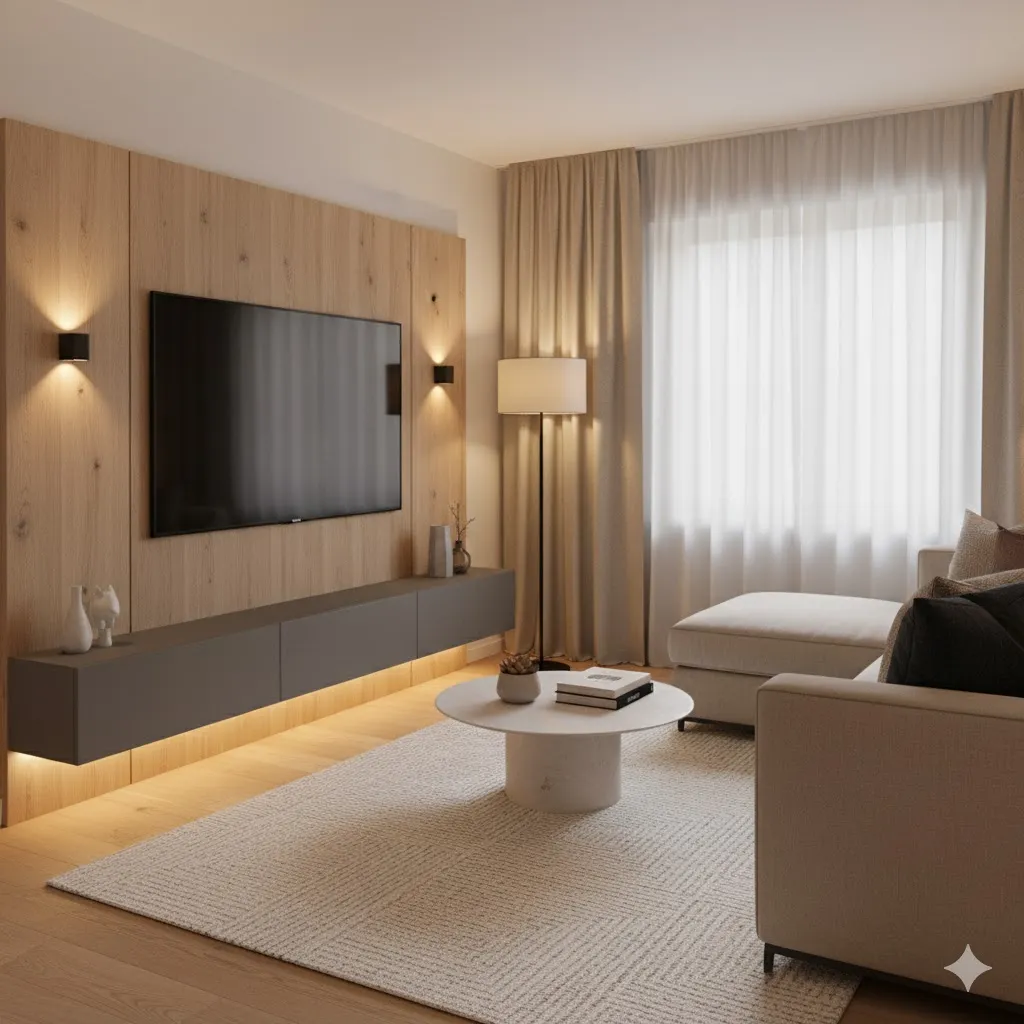
TV Wall Done Right
Mount the TV a little lower than you think (center at eye level when seated) and keep the media unit slim. Hide cables with a painted cord cover or in-wall channel. Flank the TV with two simple pieces—art, sconces, Small Living Room Layout Ideas , or picture ledges—so the wall feels finished without looking crowded. A low, long console on legs looks lighter than a chunky cabinet, and leaves space for a small basket or two underneath.
Window or Art as the Star
If the view is great, honor it. Small Living Room Layout Ideas . Angle the sofa to face the light, and keep window treatments simple and high to let more glass show. No view? Make art the star. One large piece above the sofa beats a jumble of tiny frames. Keep colors calm and repeat the art’s main tone in a cushion or throw so the room feels tied together.
3) Float the Sofa Instead of Hugging the Walls
Pushing a sofa flat against the wall can turn the room into a bowling lane. Try floating it 10–20 cm off the wall to add depth and leave space for curtains to hang well. If the room allows, bring the sofa forward with a slim console behind it for a lamp and a hidden charging spot. Floating the sofa also creates a clear walking lane behind, Small Living Room Layout Ideas , so people don’t cut through the chat circle. Finish the scene with a compact rug under the front legs and a small side table that tucks under the arm. Instantly, the room feels “designed,” not squeezed.

4) Choose Compact, Low-Profile Seating
In small rooms, visual weight matters. Go for sofas with slim arms, tight backs, and legs you can see under. A 170–190 cm two-seater often beats a giant sectional. Use medium seat depth so you sit upright to chat but can still curl up. Pick fabrics that are durable but not bulky—linen blends, performance weaves, Small Living Room Layout Ideas or boucle with a tight loop. Add one compact chair to balance the sofa without blocking paths.
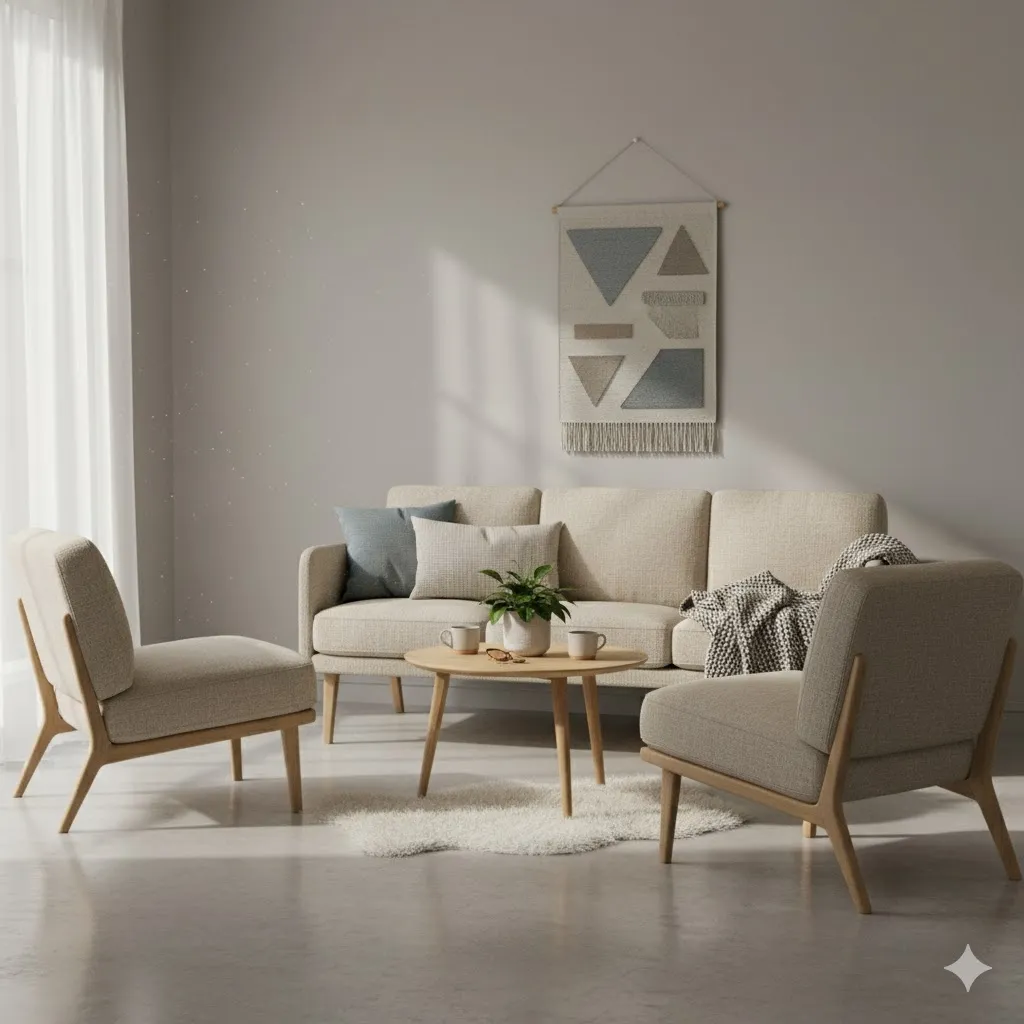
Armless and Slipper Chairs
A single armless chair or slipper chair is a space saver. It brings another seat without the chunk of big arms and tall backs. Place it at a right angle to the sofa to make a cozy L-shape, or angle it slightly to guide movement toward the window or hallway. Small Living Room Layout Ideas . If guests are common, keep a second lightweight slipper chair or a sturdy stool that can slide out on demand.
5) Swap a Bulky Coffee Table for Flexible Options
A big, heavy table eats precious floor space. Think flexible. You want pieces that move when your tasks change: morning coffee, laptop time, board games, or movie snacks. The best small-space tables nest, roll, or offer storage.

Nesting Tables
Two or three nesting tables give you surfaces when you need them and stack away when you don’t. Pull one near a chair for tea, slide another by the sofa for a laptop, Small Living Room Layout Ideas , then tuck them together before bed. Round tops soften the look and reduce toe bumps in tight walkways.
Storage Ottomans With Trays
A soft ottoman works as footrest, spare seat, and secret storage for throws and remotes. Add a firm tray on top for drinks, then lift it off for lounging. Small Living Room Layout Ideas . Square or round ottomans in neutral fabric blend in; leather adds a warm note and wipes clean easily.
6) Size the Rug to Anchor the Zone
A too-small rug makes furniture look like it’s floating apart. Aim for a rug big enough that the front legs of the sofa and chairs sit on it. This sews the seating group into one visual island and makes the room feel larger. Choose a low-pile or flatweave style so chairs glide and crumbs vacuum easily. Keep patterns gentle—tone-on-tone grids or small geometrics—to add interest without busy noise. On a tight budget, layer: a large inexpensive jute rug under a smaller patterned one gives texture and warmth for less.
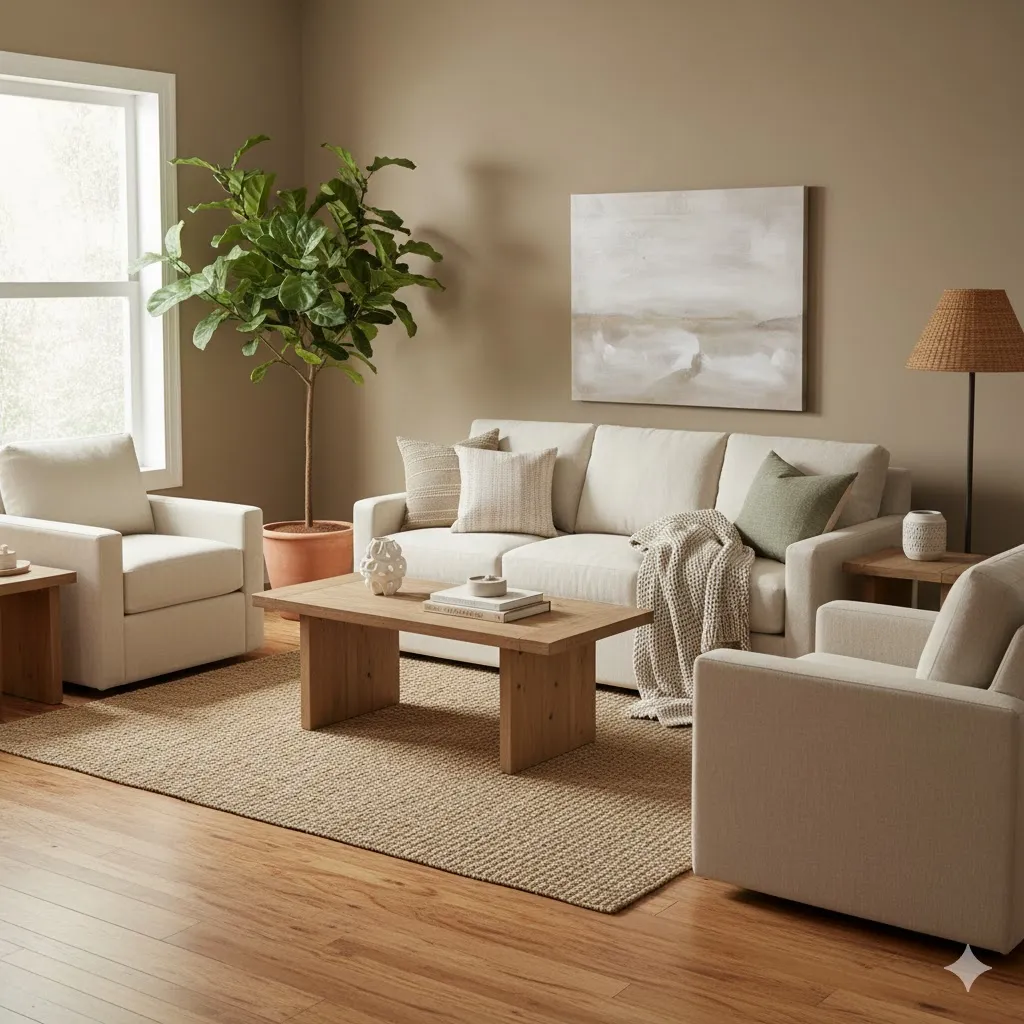
7) Create Clean Traffic Lanes
If you zigzag around furniture, the room shrinks. Plan one main lane from the door to the sofa and one smaller lane to windows or shelves. Try for 75–90 cm width; in very small rooms, 60 cm is workable. Keep table corners out of the lane, tuck cords against skirting, Small Living Room Layout Ideas and angle a chair a few degrees if it opens the path. When walking feels “automatic,” the space feels bigger—even if nothing moved.
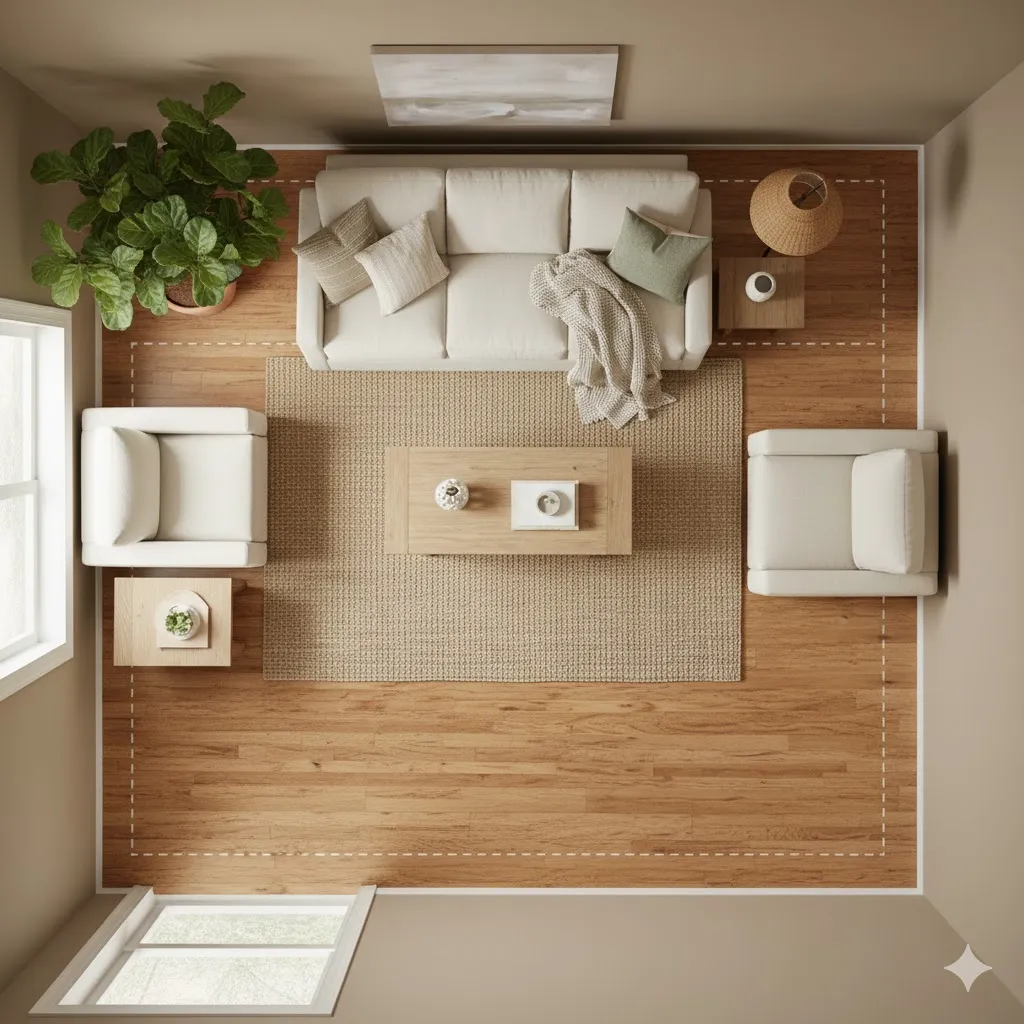
Two Simple Paths Rule
More paths = more clutter. Two is the sweet spot: a straight line to sit down and a side route to reach storage or the balcony. Small Living Room Layout Ideas. Use your rug edge or a console back to hint at the proper route and stop accidental detours through the middle of the seating zone.
8) Layer Lighting for Depth (Ambient, Task, Accent)
Lighting shapes how big a room feels after sunset. Use three layers. Ambient is your overall glow—think a soft ceiling light or paper lantern. Task lights help you read or work: a floor lamp beside the sofa, a small lamp on the console. Accent lights add warmth and depth: an LED strip under a shelf, a tiny lamp on the window ledge, Small Living Room Layout Ideas or a plug-in sconce near art. Keep bulbs warm (2700–3000K) so walls look soft, not harsh. Put lamps on a single remote or smart plug so the whole room shifts from work to movie mode with one click.
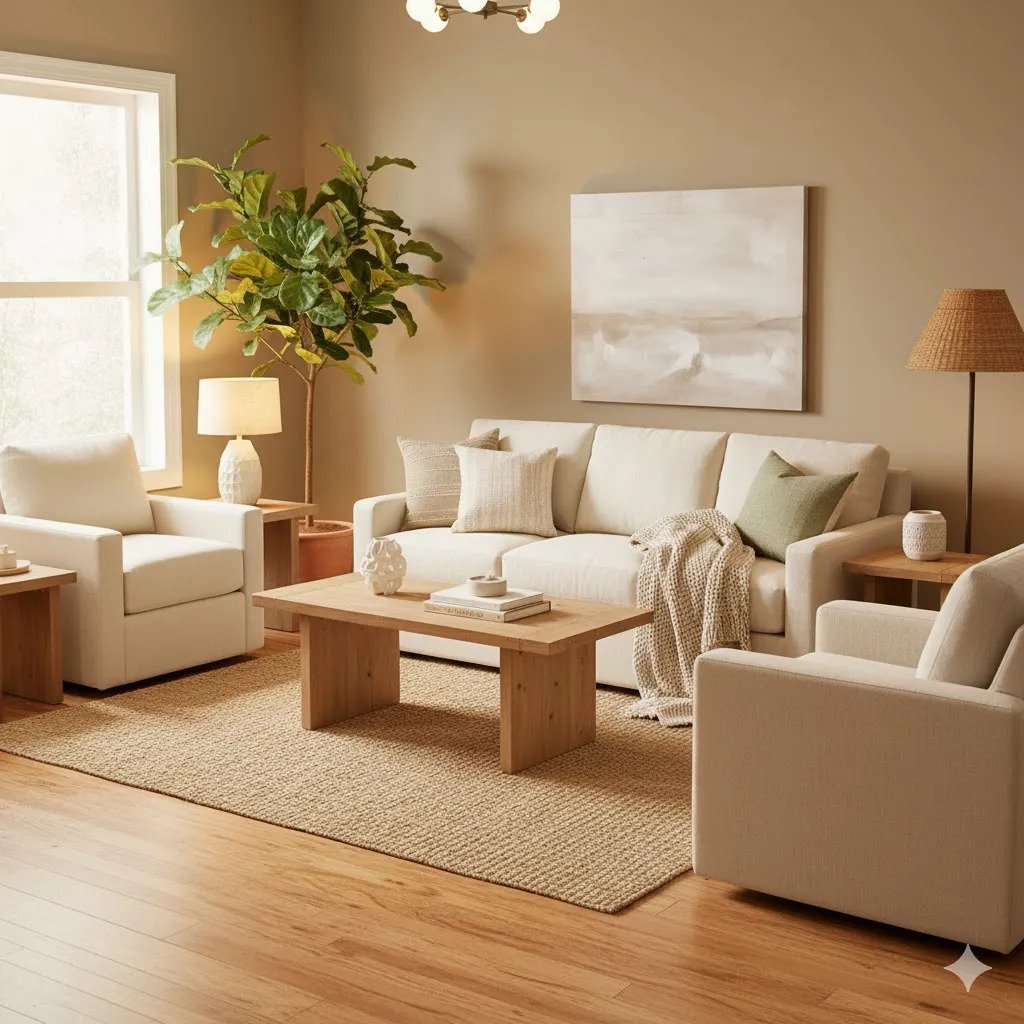
9) Go Vertical With Storage
When the floor is full, look up. Tall bookcases, wall cabinets, and picture ledges pull clutter off surfaces and add architecture to plain walls. Keep heavy items low and display light things high for balance and safety. Match storage color to your walls so it blends in, Small Living Room Layout Ideas or choose the same wood tone as your smallest table for a “family” feel. Closed doors hide cables and games; a few open shelves keep personality on show.
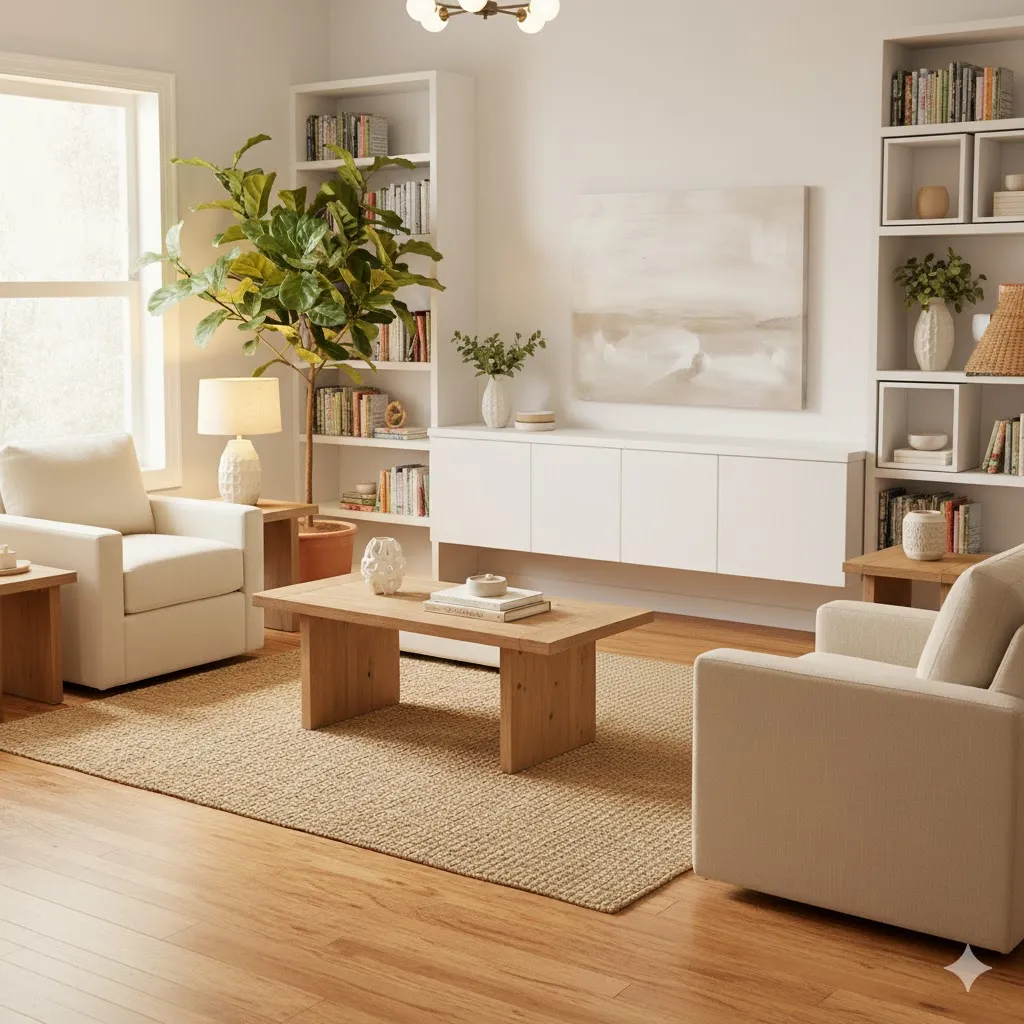
Floating Shelves and Picture Ledges
Floating shelves above the sofa hold art, books, and a small lamp without needing a side table. Picture ledges let you layer frames and swap prints quickly. In small rooms, Small Living Room Layout Ideas , run a shallow shelf the length of a wall to create a slim “console” for lighting and decor without stealing floor space.
Tall, Shallow Cabinets
A 30–35 cm deep cabinet can swallow board games, routers, and spare blankets while staying walkable. Put it on legs or float it to keep the room light. Use baskets inside to group remotes, chargers, Small Living Room Layout Ideas and seasonal items so finding things takes seconds.
10) Make Corners Work Hard
Corners are gold. Drop in a compact chair to complete an L-shape with the sofa, or tuck a tiny round table and two stools by a window for coffee and laptop time. A tall plant softens the hard angle of walls and frames the seating visually. If you need a desk, a 90–100 cm shallow table can slide into a corner without stealing the room. Treat each corner as a mini-zone with one clear job—reading, working, Small Living Room Layout Ideas or display—and your layout will feel rich, not crowded.
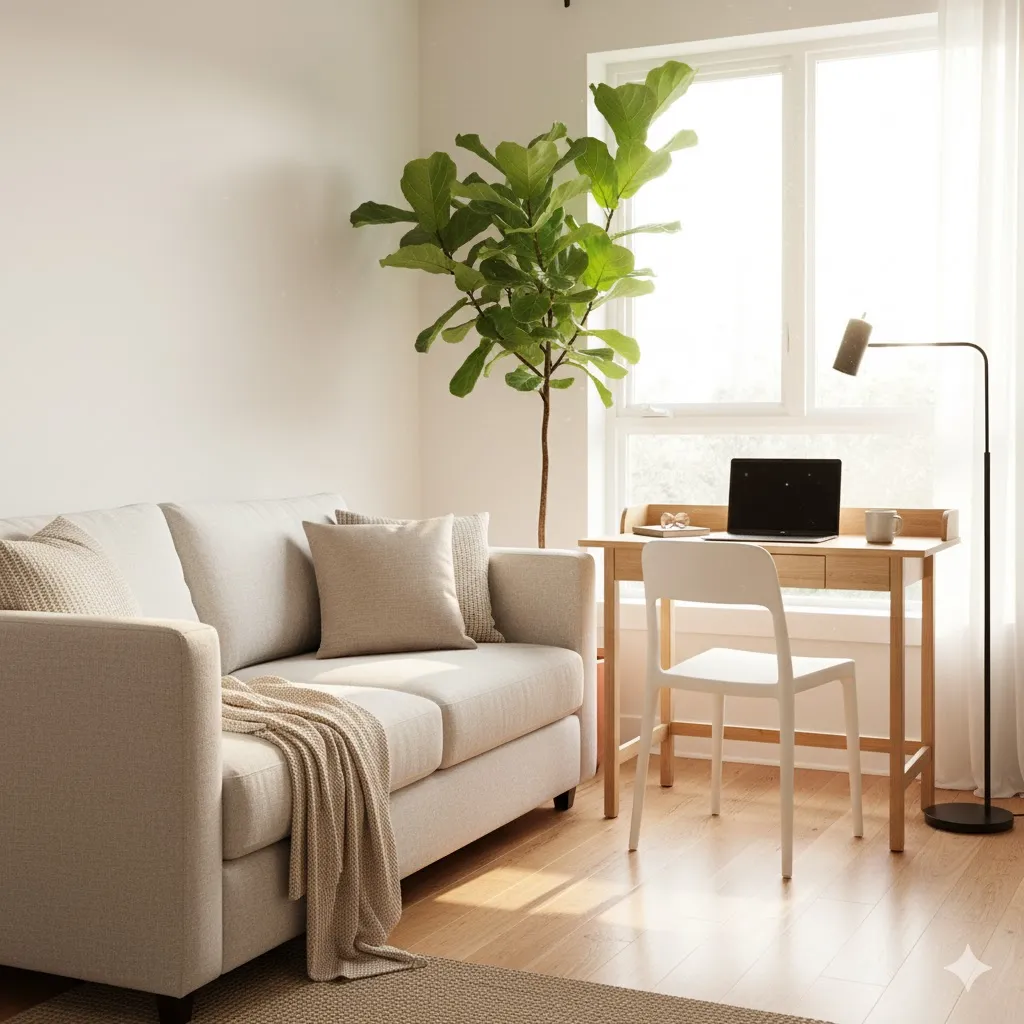
Corner Lamps
A slim arc or tripod lamp in a corner throws light across the seating zone without using table space. Choose a shade that diffuses light so the corner glows instead of glaring. This one move makes the whole room feel deeper and calmer.
Tall Plants and Mini Desks
A fiddle-leaf, rubber plant, or even a quality faux tree adds height and life. For work, a wall-mounted drop-leaf desk flips down when needed and disappears after. Small Living Room Layout Ideas . Pair it with a small stool that tucks under, and you’ve built an office without “making” one.
11) Use Mirrors and Glass to Lighten the Look
Mirrors bounce daylight and make rooms feel twice as deep. Place one opposite a window or near a lamp to spread glow. Frame choices matter: black for a crisp line, wood for warmth, brass for soft luxe. Glass tables and acrylic stools “vanish,” giving you function with almost no visual weight. If you need doors on storage, try reeded glass that blurs clutter but keeps the cabinet light. Aim mirrors at pretty views—plants, art, or tidy shelves—so what they reflect adds to the calm.
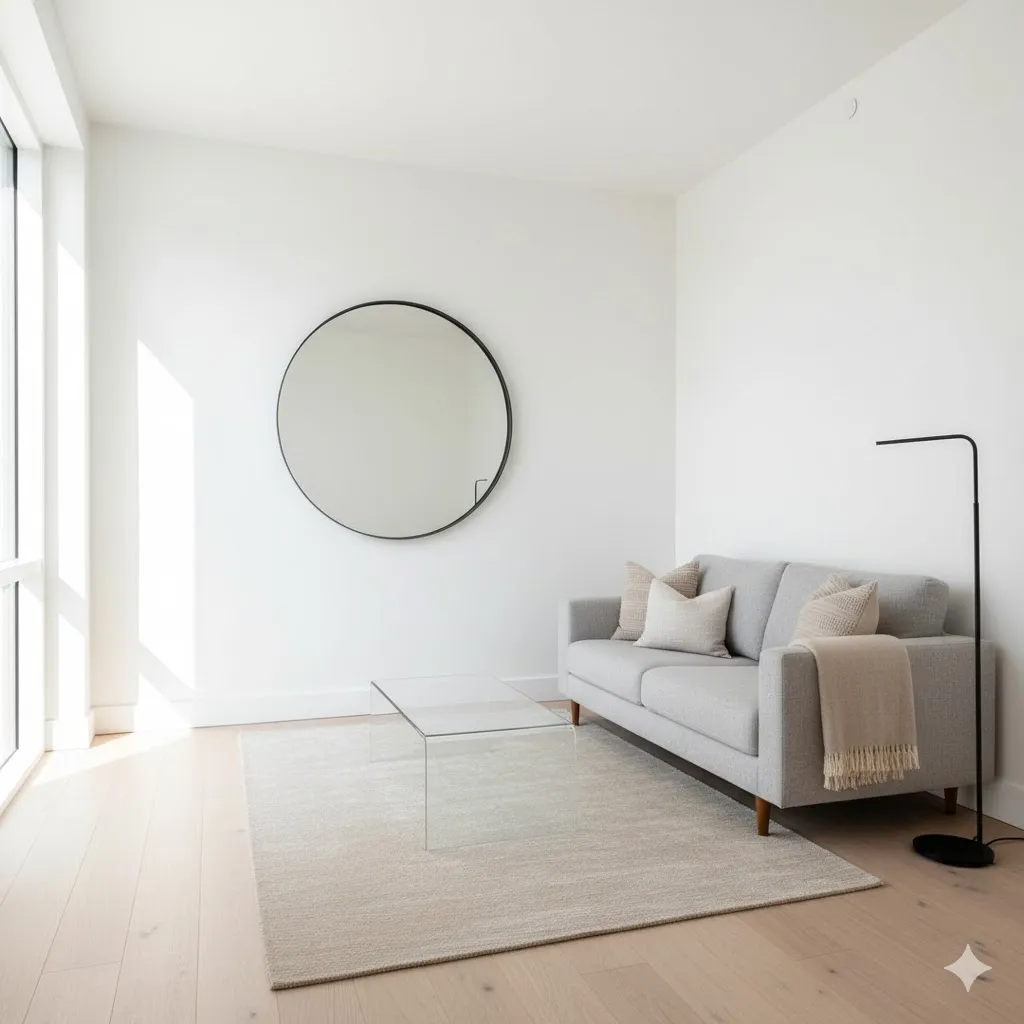
12) Try “Symmetry-Lite” Styling
Perfect twins can feel stiff in a small room. Instead, balance shapes and weights without matching everything. One tall lamp on the left, Small Living Room Layout Ideas a shorter lamp on stacked books to the right. One big artwork above the sofa and two smaller frames stacked on the other side. A full-arm chair paired with a light, armless one. This near-symmetry gives harmony and breathes easier than strict pairs, keeping the space relaxed and open.
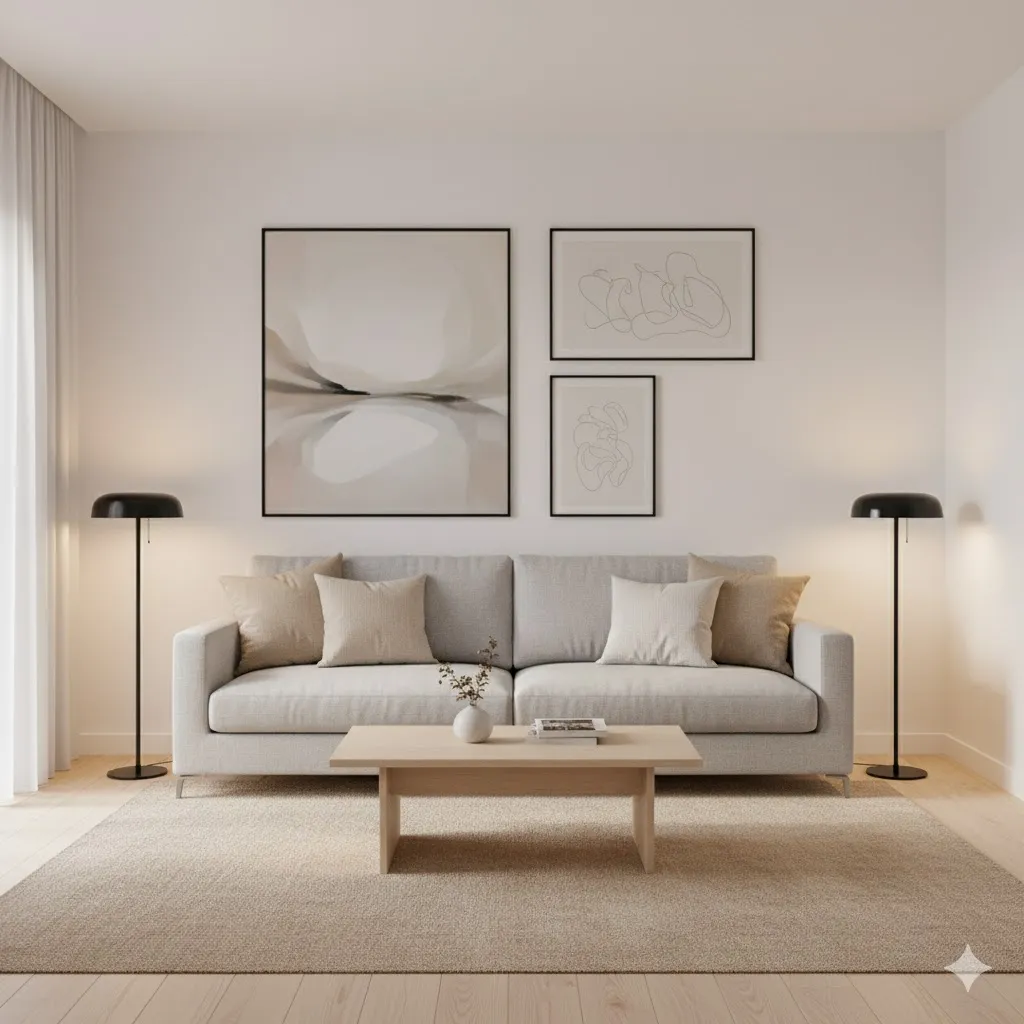
13) Keep Cords, Clutter, and Visual Noise Hidden
Nothing shrinks a room faster than cable spaghetti and busy surfaces. Use cord clips and trunking painted like the wall. Hide the router and power strip in a ventilated box under the console. Keep remotes and chargers in a lidded tray or drawer. Style the coffee table with just three items of different heights and textures—a plant, a candle, and a book stack—and leave empty space for real life. When the eye rests, the room feels bigger.

14) Add Flexible Extras: Stools, Poufs, and Foldables
Small rooms need shape-shifters. Two stacking stools live under the console and pop out for guests. Poufs slide under the coffee table and become feet-up comfort or side seating. A folding side table hides behind the sofa and appears for game night. Choose neutral, durable fabrics so these helpers blend in. The rule: if a piece can do two jobs or disappear when not needed, it earns its place.

15) Do a Five-Minute Weekly Reset
Design is not a one-time act; it’s a tiny habit. Once a week, set a timer for five minutes. Fluff cushions, fold throws, clear cups, return wandering chargers to their box, and recycle old mail. While you reset, ask: “Did I use this here?” If not, re-home it. Rotate a cushion cover for the season, swap a print on the ledge, or refresh a plant pot. Small, regular edits protect your layout and keep the room calm and welcoming—no big clean needed.
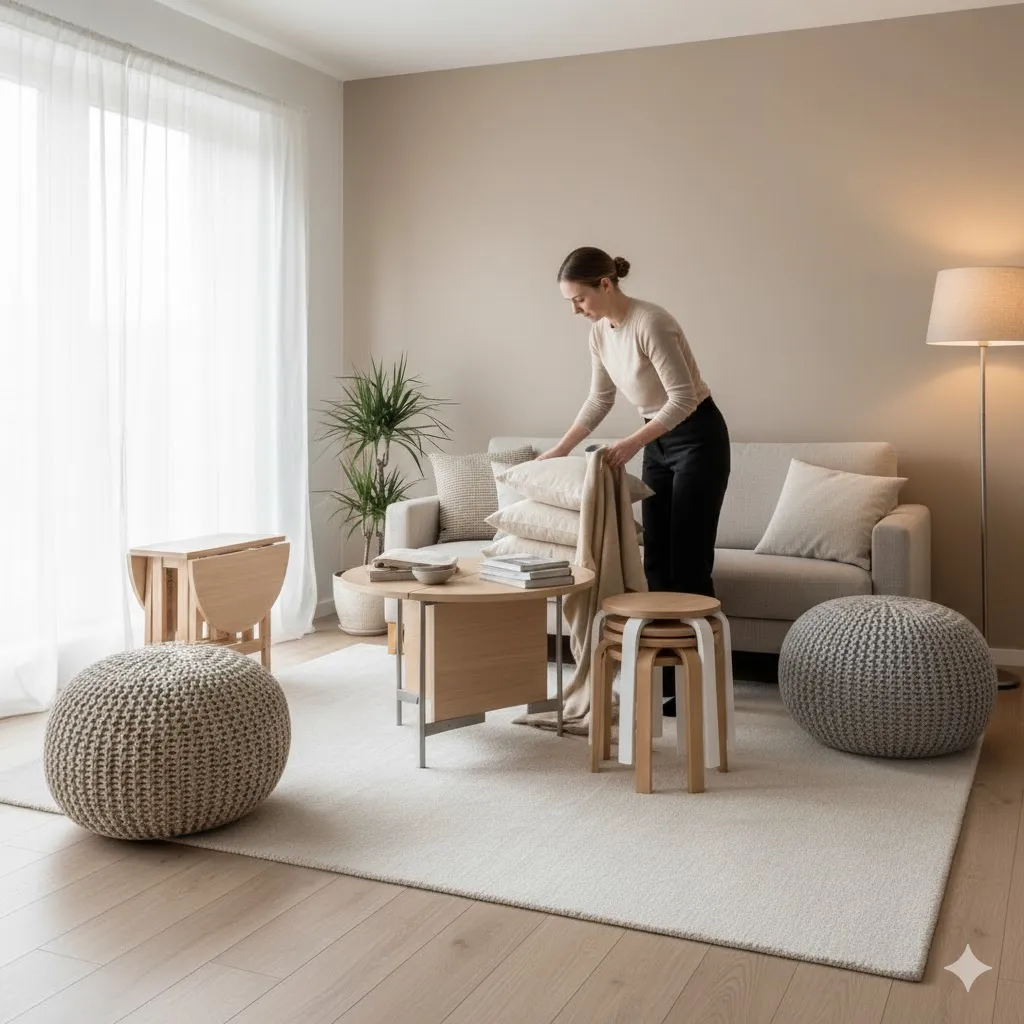
Conclusion
You don’t need a bigger living room to live bigger—you need a better layout. Measure, plan, and protect simple routes so movement feels natural. Give your eyes one clear focal point, float the sofa for depth, and choose compact seating that looks light on its feet. Anchor everything with a right-sized rug, build storage up the walls, and turn forgotten corners into useful mini-zones. Add layered lighting for evening depth, mirrors and glass to brighten the scene, and “symmetry-lite” styling for balance without stiffness. Hide cords, keep surfaces calm, and rely on flexible helpers—stools, poufs, foldables—to adapt the room in seconds.
FAQs
1) What’s the best sofa size for a tiny room?
Aim for 170–190 cm with slim arms and visible legs. Pair it with one compact chair or two poufs rather than a second bulky seat. This keeps paths open and the room balanced.
2) How far should the TV be from the sofa?
A simple guide is 1.5× the screen diagonal. For a 43-inch TV, about 1.6 meters is comfortable. If space is tight, lower the screen slightly and dim lights to reduce eye strain.
3) Which rug shape works best?
Rectangular rugs anchor classic layouts; round rugs soften narrow rooms and ease traffic around corners. Whichever you choose, get it large enough for the front legs of seating to sit on it.
4) Are sectionals a bad idea in small spaces?
Not always. A compact L-shaped sectional with a chaise can replace two chairs and free floor. Keep the back low, arms slim, and let one side float a few centimeters off the wall.
5) How can I add storage without making the room heavy?
Go vertical and shallow. Float shelves, use picture ledges, and pick tall cabinets with doors in the wall color. Store messy items behind doors and display a few favorites openly for balance.







